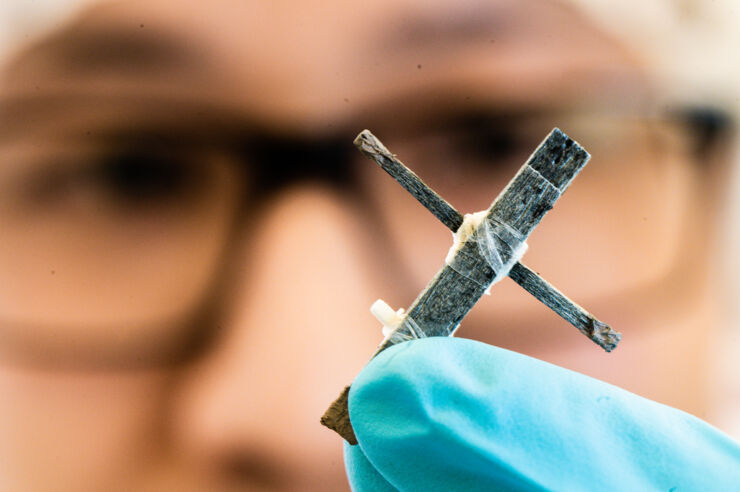Transistors, invented almost one hundred years ago, are considered by some to be an invention just as important to humanity as the telephone, the light bulb or the bicycle. Today, they are a crucial component in modern electronic devices, and are manufactured at nanoscale. A transistor regulates the current that passes through it and can also function as a power switch.
Researchers at Linköping University, together with colleagues from the KTH Royal Institute of Technology, have now developed the world’s first electrical transistor made of wood.
“We’ve come up with an unprecedented principle. Yes, the wood transistor is slow and bulky, but it does work, and has huge development potential,” says Isak Engquist, senior associate professor at the Laboratory for Organic Electronics at Linköping University.
Balsa wood

© Thor Balkhed
In previous trials, transistors made of wood have been able to regulate ion transport only. And when the ions run out, the transistor stops functioning. The transistor developed by the Linköping researchers, however, can function continuously and regulate electricity flow without deteriorating.
The researchers used balsa wood to create their transistor, as the technology involved requires a grainless wood that is evenly structured throughout. They removed the lignin, leaving only long cellulose fibres with channels where the lignin had been.
These channels were then filled with a conductive plastic, or polymer, called PEDOT:PSS, resulting in an electrically conductive wood material.
The researchers used this to build the wood transistor and could show that it is able to regulate electric current and provide continuous function at a selected output level. It could also switch the power on and off, albeit with a certain delay – switching it off took about a second; on, about five seconds.

Regulation of electronic plants
Possible applications could include regulating electronic plants, which is another strong research area at Linköping University. One advantage of the transistor channel being so large is that it could potentially tolerate a higher current than regular organic transistors, which could be important for certain future applications. But Isak Engquist wants to stress something:
“We didn’t create the wood transistor with any specific application in mind. We did it because we could. This is basic research, showing that it’s possible, and we hope it will inspire further research that can lead to applications in the future,” says Isak Engquist.
The study was financially supported by the Knut and Alice Wallenberg Foundation through the Wallenberg Wood Science Center.
Original Article
Electrical current modulation in wood electrochemical transistor; Van Chinh Tran, Gabriella G. Mastantuoni, Marzieh Zabihipour, Lengwan Li, Lars Berglund, Magnus Berggren, Qi Zhou, Isak Engquist; PNAS Volume 120, published online on 24 April 2023. DOI: 10.1073/pnas.2218380120

Contact
Isak Engquist
Tel.: +4611363401
e-Mail: isak.engquist@liu.se
Author
Anders Törneholm
Source
University of Linköping, press release, 2023-04-28.
Supplier
KTH Royal Institute of Technology
Linköping University
Proceedings of the National Academy of Sciences of the USA (PNAS)
Wallenberg Wood Science Center WWSC (KTH)
Share
Renewable Carbon News – Daily Newsletter
Subscribe to our daily email newsletter – the world's leading newsletter on renewable materials and chemicals










